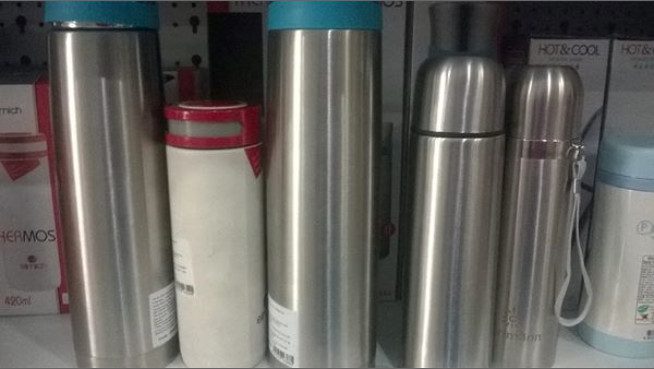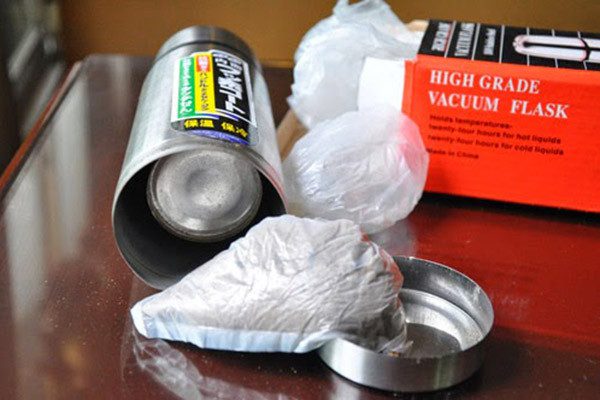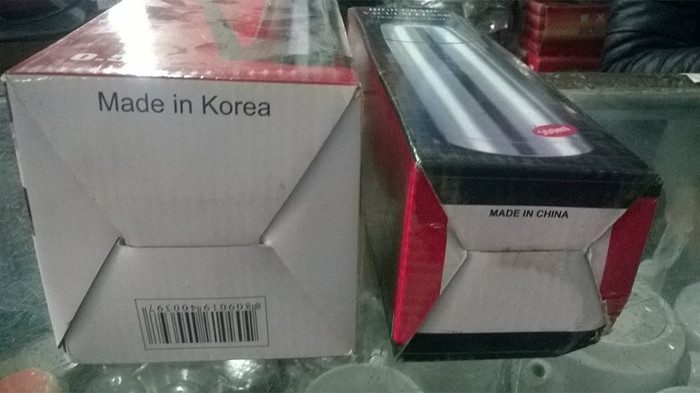Information about Chinese thermos bottles containing cancer-causing substances is alarming consumers. Even more concerning, these products are widely available in the Vietnamese market. Therefore, it is essential for consumers to know how to choose quality thermos bottles to protect the health of their families.
Recently, information has emerged that Chinese stainless steel thermos bottles contain carcinogenic substances, which are commonly used in Vietnam. Professor Dr. Nguyen Hai Nam from the University of Pharmacy stated that it is not just thermos bottles that are a concern; all stainless steel and plastic items should not be used to store acidic liquids for extended periods, as this may lead to cancer.
Prior to this, the Chinese government issued a warning to consumers about thermos bottles containing cancer-causing substances. This result came from experiments conducted by the Quality Research and Testing Institute in Jiangsu Province, China, in collaboration with various agencies at the end of February.
During the experiment, experts filled two samples of the same type of thermos bottles with pure water and fruit juice. After a period, the heavy metal content in the fruit juice significantly increased and exceeded permissible limits. No similar phenomenon was observed in the pure water sample.

Carefully observe and compare the weight between different thermos bottles. Typically, Chinese thermos bottles are much lighter than those from South Korea, Thailand, etc.
In a discussion with Associate Professor Nguyen Duy Thinh from the Institute of Biotechnology and Food Technology at Hanoi University of Science and Technology regarding the issue of carcinogenic stainless steel thermos bottles, Associate Professor Thinh advised that the public should not panic too much about this information.
According to Associate Professor Thinh, stainless steel is widely used in daily life, from staircases to door handles, with some items related to food and drink, such as bowls, chopsticks, and spoons. Stainless steel has excellent heat retention properties, making it suitable for manufacturing thermos bottles.
He explained that stainless steel is a compound made up of various elements. The quality of each product depends on the type of stainless steel chosen by the manufacturer. However, products that contain high levels of metals such as chromium, manganese, and nickel can adversely affect consumer health.
“The type of stainless steel used to produce food-related items like thermos bottles, chopsticks, spoons, bowls, etc., must be made from quality stainless steel that does not rust and does not react chemically with the contents it holds,” said Professor Thinh. Therefore, consumers should select and purchase products that have passed legal quality inspections to ensure safety.
Some tips for choosing quality thermos bottles:

Chinese thermos bottles are usually slimmer and more aesthetically pleasing than other types.
- Use a magnet ball to test; the stronger the attraction, the more iron it contains, indicating poor quality and a tendency to rust quickly.
- Purchase items that have the manufacturer’s label or tag.
- Thermos bottles from Thailand, South Korea, Vietnam, etc., often contain moisture-absorbing packets inside, while most Chinese thermos bottles do not.
- Chinese thermos bottles are significantly lighter and usually lack moisture-absorbing packets, often having an unpleasant odor.
- Quality thermos bottles from South Korea, Thailand, and Japan typically range from 150,000 VND per bottle and above, whereas Chinese thermos bottles are priced at less than half. Additionally, Chinese bottles tend to have slimmer designs and more attractive appearances compared to other types.
- For cooking, select stainless steel marked as 304; for non-cooking products, choose 430. When purchasing, ask the seller to provide the correct type.
- Those with 2-3 thick layers at the bottom will not produce an echo when tapped, while thin, single-layer bottoms will create a more resonant sound. Some manufacturers produce thin stainless steel but apply a coating at the bottom to dampen sound, which can be easily detected as they feel lighter than normal bottles.
- Good products are usually cast in one piece without any seams or joints. Products that are “spot-welded” leave burn marks at the handle joints or seams.
- Bottles with inner cores made of the same material as the shell can hold water at 100 degrees Celsius but will retain heat for only 8-24 hours (hot-cold); those with a silicon coating can retain ice for up to 48 hours but should only be used for water below 70 degrees Celsius.
- Typically, tested products from reputable brands in South Korea, Thailand, Japan, etc., have anti-counterfeiting labels and barcodes attached to the outer packaging, whereas Chinese products usually do not.
However, to deceive consumers, some vendors create fake labels and barcodes that are indistinguishable from genuine products. If you are not a frequent buyer of thermos bottles, it is advisable to purchase them at reputable supermarkets or stores. Particularly, be cautious of street vendors and market stalls…

Chinese thermos bottles usually do not have barcodes printed on the bottom of the box.
Usage Tips for Thermos Bottles
- On first use, fill the bottle with hot water (for heat retention) or cold water (for cold retention) and let it soak for about two minutes to clean and enhance heat retention.
- Use specific bottles for hot or cold; do not mix them.
- Always pour water to about 2cm from the top of the bottle to allow for slower heat transfer, potentially retaining temperature longer.
- Avoid using the bottle for carbonated drinks, fruit juices, or milk.
- After some time, the bottle may develop rust spots. Pour a diluted vinegar solution into the bottle and soak for about 30 minutes, then wipe it dry with a soft cloth, and the rust spots will disappear.
- Clean the bottle thoroughly right after use.
- Avoid placing the bottle in extremely high or low temperatures (depending on whether it is meant for hot or cold) as this can reduce its heat retention ability.


















































